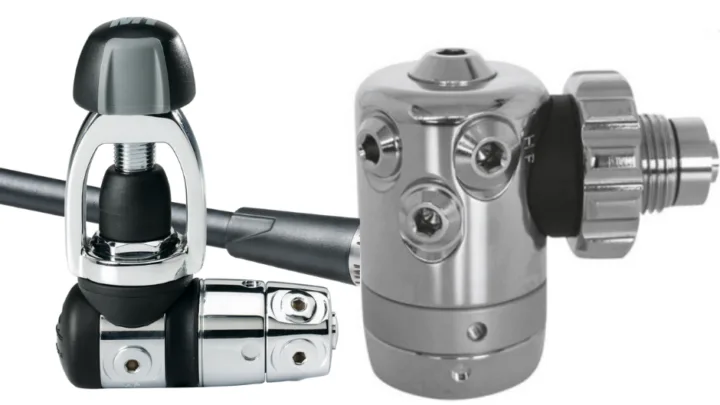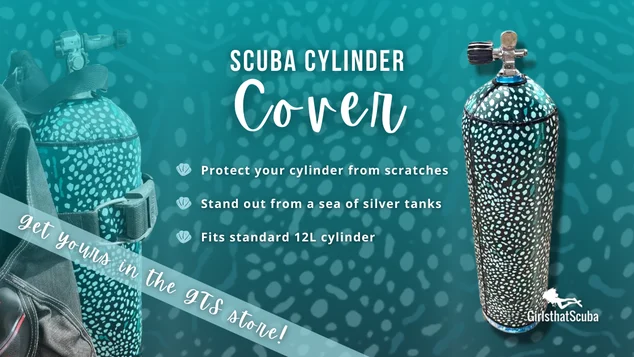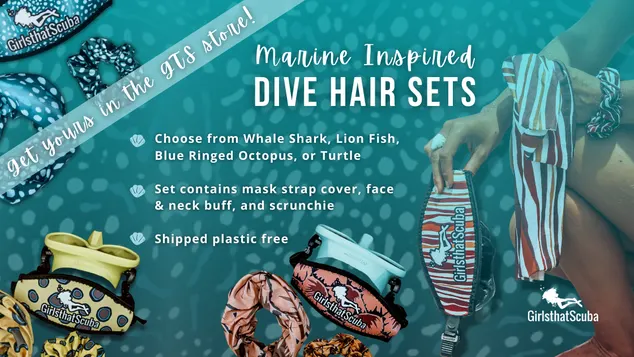One of the first decisions to make when choosing a new regulator is which style of first stage to opt for. DIN vs yoke has been debated over and over, and with so many varied opinions we wanted to lay out the pros and cons of both, as well as giving you all the information on what the difference is between A-clamp vs DIN, and whether you can use a DIN first stage on a yoke cylinder valve. Read on to become the expert on all things valves and regulator first stages!
What’s the difference between a DIN and yoke regulator first stage?
Choosing a regulator first stage can be a challenge if you don’t understand how DIN and yoke styles differ. Ultimately, it comes down to how they attach, and the location of the o-ring. On a yoke first stage, also known as an a-clamp style, the o-ring is exposed on the cylinder valve. The first stage then has an opening which connects to this exposed o-ring, and a pin which screws into the back of the cylinder valve to hold it in place. The regulator becomes sealed once it’s pressurised by turning the cylinder on.
DIN (an acronym of Deutsche Industrie Norm) differs as it is a threaded opening which screws directly into the cylinder valve. On a DIN regulator, the o-ring is built into the first stage rather than sitting on the valve. Next up, we’ll share the advantages of a DIN regulator and why they’re becoming the norm within modern scuba diving.
Advantages of a DIN first stage
Both yoke and DIN have their advantages, but the pros for DIN are predominantly safety related. Here’s the reasons why you may want to opt for a DIN first stage on your next regulator purchase.
Secure Seal
We’ve all been behind another diver in a group and seen that familiar stream of bubbles slowly leaking from their yoke first stage. Whilst slow leaks aren’t necessarily a problem (hands up if you’ve heard the phrase “small bubbles, no troubles”) they can be an early indicator of a more significant leak, or even the possibility of an o-ring blow-out. With a DIN regulator the o-ring is built into the first stage of the regulator as opposed to being more exposed on the cylinder valve, so this tighter seal means that the likelihood of leaks is much lower.
Pressure Capacity
DIN first stages can have a much higher pressure capacity than their yoke counterparts, with some models performing up to 300 bar. However, it isn’t a strict rule that all DIN valves are usable up to this pressure, so you should always check with the manufacturer of your regulator to determine what the maximum working pressure of the first stage is.
Cold Water
If you’re brave enough to be plunging into colder waters (anything below 10°c), it’s widely accepted that DIN is the way to go. You should be looking for a regulator which is also environmentally sealed and tested for use in colder waters.
Lower Profile
A DIN first stage is considerably less bulky than a yoke and is overall more streamlined, with less risk of it snagging on anything. This is advantageous if you ever end up diving in any overhead environments such as wrecks, caverns or caves, which brings us nicely onto our next point…
Future Proof
Within the technical diving community, DIN is the standard as it is considered much safer. If technical diving is on the cards for you, it’s worth future proofing your regulator purchase by going straight for a DIN rather than purchasing a yoke and then wanting to change it later on.
Advantages of a yoke or A-clamp first stage
With the safety advantages listed above, it’s easy to see why the industry is heading more towards DIN being the standard. Ultimately, as with buying any piece of scuba equipment you need to make the best choice for you and the type of diving you’ll be doing. However, there are still some situations where yoke might take the lead over DIN for being the best choice.
Location
There are some locations around the world where yoke is the standard, and where cylinders are set up with yoke valves to match (we’ll get on to how to adapt tanks and regulators later on). Yoke is commonly used in parts of the US, the Caribbean, areas of Australia, and some parts of Asia. If you know that all of your diving will be in one of these locations then it may be worth sticking to a yoke first stage in order to minimise having to use adapters.
Ease of Use
Some people find the screw in of a DIN valve slightly trickier to get to grips with, so putting on and removing a yoke valve can be comparatively easier. Whilst this won’t be a factor for most people, if you have any mobility issues in your hands on wrists then this could be a vote for yoke for you.
Can I use a DIN regulator on a yoke cylinder valve?
There are multiple options for how to use a DIN regulator on a yoke cylinder valve. Modern scuba cylinders often have interchangeable valves, so it can be as simple as carrying an allen key to unscrew the yoke valve and change it into a DIN valve. If this isn’t the case and you’re diving in a location where the tanks are only yoke valves, you can use an adapter to change your first stage. These simply screw onto the DIN opening and then extend it into an a-clamp style, allowing it to be screwed onto a yoke valve. The downside to this is that they can be bulky when in use, and can be a weighty addition to your “save a dive kit” if you’re more of a travelling diver.
Is there a yoke to DIN adapter?
Whilst there isn’t a way to change the first stage itself from yoke to DIN, adapting a DIN cylinder valve for use with a yoke first stage is very simple. As previously mentioned, you simply need to screw in a small adapter to change the valve to a yoke valve. This is a small piece with an exposed o-ring which threads into the cylinder valve. If you opt for a yoke regulator setup, it’s always worth carrying one of these small adapters and an allen key with your equipment – they’re extremely affordable and take up very little space.
Which style first stage do you have, DIN or yoke? Or if you’re in the market for new regulators, which will you be buying next? Let us know in the comments, continue the conversation in or Girls that Scuba Facebook group, and tag us on Instagram @girlsthatscuba to show off your shiny new reg purchases!







